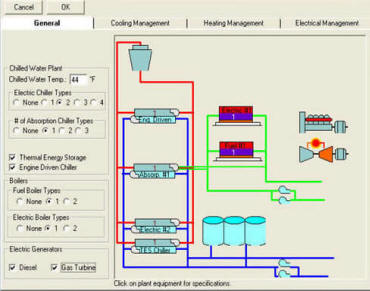Energy Modeling and Economic
Analysis
A complete energy audit--including condition survey, utility bill analysis, benchmarking, and control strategies--is the process by which Energy Cost Reduction Measures (ECRMs) for your building are evaluated. However, simply compiling a list of likely ECRMs will not give you all the information you need to make the most informed decisions.
ECRMs are not just additive; they are interactive. For example: one of the byproducts of lighting is heat. Older inefficient lighting produces
more heat than newer more efficient lighting. If you install new lighting your heating load (the amount of heat your system needs to produce) will actually increase and your air conditioning load will decrease. The best way to estimate
the interactive impact of various ECRMs is through a two step
process that includes computer modeling and economic analysis.
Computer-Aided Energy Simulation –
Energy Modeling
 To meet the growing demand for “green” buildings, Informed Energy Decisions uses energy modeling to better advise our clients faced with rehab or new construction of commercial, institutional, or residential buildings. Computer-aided energy simulation ("energy modeling") allows us to make accurate predictions about the impact that each element of construction or rehab could have on the building's future energy consumption and cost. The simulations allow us to develop strategies that will make the most of the monies invested in your project.
To meet the growing demand for “green” buildings, Informed Energy Decisions uses energy modeling to better advise our clients faced with rehab or new construction of commercial, institutional, or residential buildings. Computer-aided energy simulation ("energy modeling") allows us to make accurate predictions about the impact that each element of construction or rehab could have on the building's future energy consumption and cost. The simulations allow us to develop strategies that will make the most of the monies invested in your project.
Over the past several decades, energy simulation has become highly advanced. Prior to actual implementation, modeling helps determine best design for new and retrofit construction and best energy-saving operations practices once the building is occupied. Energy modeling is also an essential component in measuring compliance with green building standards such as LEED and Energy Star™.
Building Heating/Cooling Load Calculation
Energy simulation is used to determine the appropriate size for HVAC equipment, systems, and plants. Appropriate sizing is critical: it assures that the building has just the right amount of heating, air conditioning, and lighting to serve the occupants. A building can have too much equipment, leading to unintended comfort problems and expenses. When a building is renovated, changes in heating and cooling loads can also lead to equipment being oversized.
Building Energy Management and
Control System (EMCS) Design
Enthalpy control (for heat and humidity), night setback,
optimal start/stop control, other control equipment and
management practices can be modeled to determine the best means
for maximizing the energy efficiency of building systems.


Complying with
Building Regulations, Codes, and Standards
Computer simulation allows automatic reviews
for compliance with building regulations, codes, and standards
related to energy use and mechanical design. Compliance
reviews conducted through simulation minimize the possibility
of human error while making critical calculations.
Cost Analysis
Building energy simulations can model the
relative performance of multiple energy-saving alternatives and
the interactions between them.
Performance projections can be used to
determine simple payback, net present value, internal rate of
return, etc. for various energy improvements, making it possible
to select the most cost-effective options. Cost analysis
can also be designed to reflect predicted changes in energy
costs.
|
Energy Cost Reduction Measure
(ECRM)
|
ID
|
Study Period
|
Additional First Cost
|
Annual Savings
|
Monthly Savings
|
Monthly Loan Payment
|
Net Monthly Cash Flow
|
|
ECRM 1
|
ECRM1
|
15
|
$1
|
$34,547
|
$2,879
|
($0)
|
$2,879
|
|
ECRM 2
|
ECRM2
|
15
|
$750
|
$1,439
|
$120
|
($7)
|
$113
|
|
ECRM 3
|
ECRM3
|
15
|
$25,000
|
$11,448
|
$954
|
($225)
|
$729
|
|
ECRM 4
|
ECRM4
|
15
|
$600
|
$1,880
|
$157
|
($5)
|
$151
|
|
ECRM 5
|
ECRM5
|
15
|
$1
|
$1,400
|
$117
|
($0)
|
$117
|
|
ECRM 6
|
ECRM6
|
15
|
$10,500
|
$3,934
|
$328
|
($94)
|
$233
|
Performance-Based Certification
Informed Energy uses software that is
approved for verifying compliance with several "green building"
performance standards, including LEED, Energy Star™, and National
Association of Home Builders Green Homes.